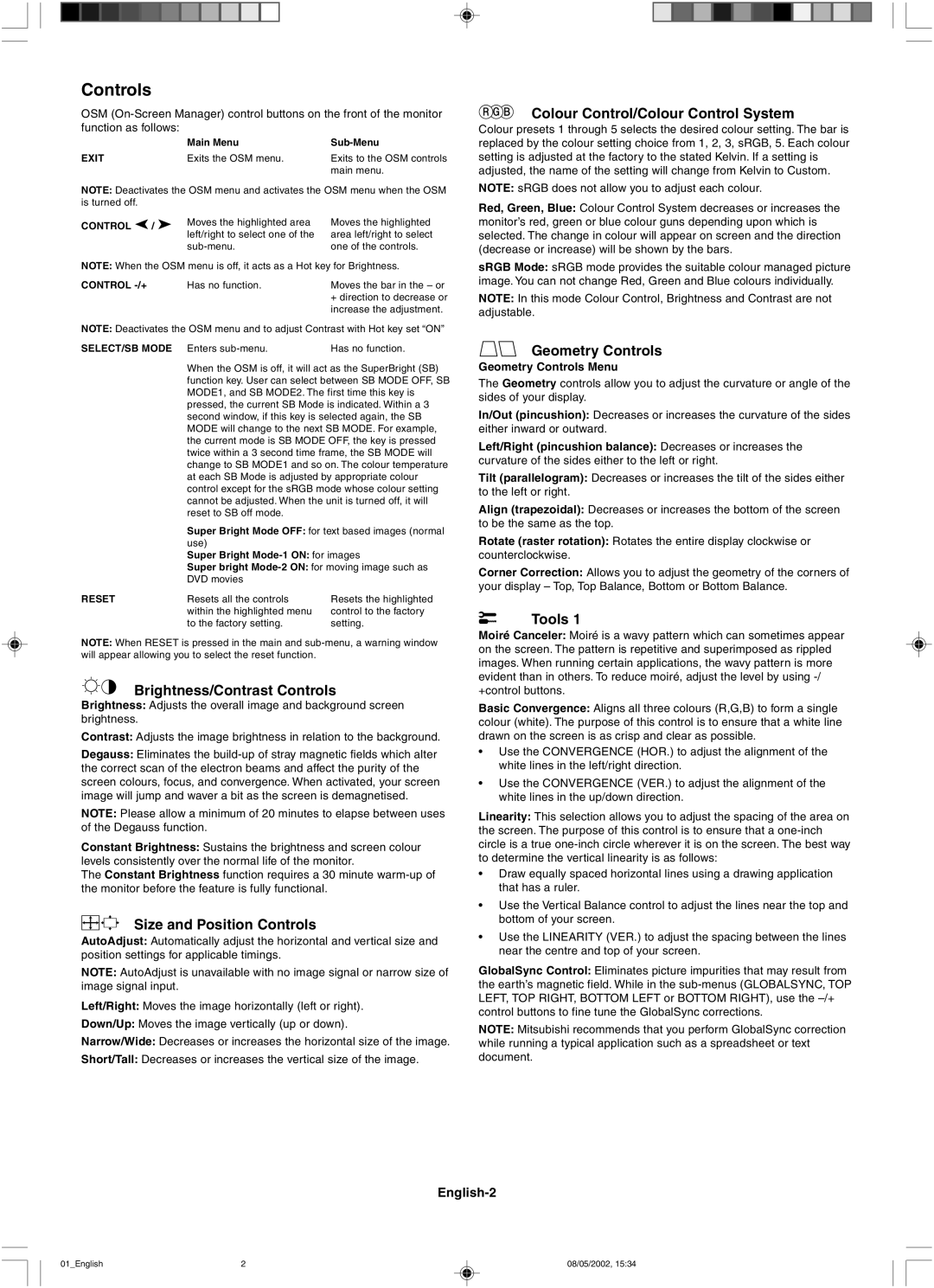
Controls
OSM
| Main Menu | |
EXIT | Exits the OSM menu. | Exits to the OSM controls |
|
| main menu. |
NOTE: Deactivates the OSM menu and activates the OSM menu when the OSM is turned off.
CONTROL | / | Moves the highlighted area | Moves the highlighted | |
left/right to select one of the | area left/right to select | |||
|
| |||
|
| one of the controls. | ||
NOTE: When the OSM menu is off, it acts as a Hot key for Brightness. | ||||
CONTROL |
| Has no function. | Moves the bar in the – or | |
|
|
| + direction to decrease or | |
|
|
| increase the adjustment. | |
NOTE: Deactivates the OSM menu and to adjust Contrast with Hot key set “ON”
SELECT/SB MODE Enters | Has no function. |
When the OSM is off, it will act as the SuperBright (SB) function key. User can select between SB MODE OFF, SB MODE1, and SB MODE2. The first time this key is pressed, the current SB Mode is indicated. Within a 3 second window, if this key is selected again, the SB MODE will change to the next SB MODE. For example, the current mode is SB MODE OFF, the key is pressed twice within a 3 second time frame, the SB MODE will change to SB MODE1 and so on. The colour temperature at each SB Mode is adjusted by appropriate colour control except for the sRGB mode whose colour setting cannot be adjusted. When the unit is turned off, it will reset to SB off mode.
Super Bright Mode OFF: for text based images (normal use)
Super Bright
Super bright
DVD movies
RESET | Resets all the controls | Resets the highlighted |
| within the highlighted menu | control to the factory |
| to the factory setting. | setting. |
NOTE: When RESET is pressed in the main and
Brightness/Contrast Controls
Brightness: Adjusts the overall image and background screen brightness.
Contrast: Adjusts the image brightness in relation to the background.
Degauss: Eliminates the
NOTE: Please allow a minimum of 20 minutes to elapse between uses of the Degauss function.
Constant Brightness: Sustains the brightness and screen colour levels consistently over the normal life of the monitor.
The Constant Brightness function requires a 30 minute
Size and Position Controls
AutoAdjust: Automatically adjust the horizontal and vertical size and position settings for applicable timings.
NOTE: AutoAdjust is unavailable with no image signal or narrow size of image signal input.
Left/Right: Moves the image horizontally (left or right).
Down/Up: Moves the image vertically (up or down).
Narrow/Wide: Decreases or increases the horizontal size of the image.
Short/Tall: Decreases or increases the vertical size of the image.
Colour Control/Colour Control System
Colour presets 1 through 5 selects the desired colour setting. The bar is replaced by the colour setting choice from 1, 2, 3, sRGB, 5. Each colour setting is adjusted at the factory to the stated Kelvin. If a setting is adjusted, the name of the setting will change from Kelvin to Custom.
NOTE: sRGB does not allow you to adjust each colour.
Red, Green, Blue: Colour Control System decreases or increases the monitor’s red, green or blue colour guns depending upon which is selected. The change in colour will appear on screen and the direction (decrease or increase) will be shown by the bars.
sRGB Mode: sRGB mode provides the suitable colour managed picture image. You can not change Red, Green and Blue colours individually.
NOTE: In this mode Colour Control, Brightness and Contrast are not
adjustable.
Geometry Controls
Geometry Controls Menu
The Geometry controls allow you to adjust the curvature or angle of the sides of your display.
In/Out (pincushion): Decreases or increases the curvature of the sides either inward or outward.
Left/Right (pincushion balance): Decreases or increases the curvature of the sides either to the left or right.
Tilt (parallelogram): Decreases or increases the tilt of the sides either to the left or right.
Align (trapezoidal): Decreases or increases the bottom of the screen to be the same as the top.
Rotate (raster rotation): Rotates the entire display clockwise or counterclockwise.
Corner Correction: Allows you to adjust the geometry of the corners of your display – Top, Top Balance, Bottom or Bottom Balance.
Tools 1
Moiré Canceler: Moiré is a wavy pattern which can sometimes appear on the screen. The pattern is repetitive and superimposed as rippled images. When running certain applications, the wavy pattern is more evident than in others. To reduce moiré, adjust the level by using
Basic Convergence: Aligns all three colours (R,G,B) to form a single colour (white). The purpose of this control is to ensure that a white line drawn on the screen is as crisp and clear as possible.
•Use the CONVERGENCE (HOR.) to adjust the alignment of the white lines in the left/right direction.
•Use the CONVERGENCE (VER.) to adjust the alignment of the white lines in the up/down direction.
Linearity: This selection allows you to adjust the spacing of the area on the screen. The purpose of this control is to ensure that a
•Draw equally spaced horizontal lines using a drawing application that has a ruler.
•Use the Vertical Balance control to adjust the lines near the top and bottom of your screen.
•Use the LINEARITY (VER.) to adjust the spacing between the lines near the centre and top of your screen.
GlobalSync Control: Eliminates picture impurities that may result from the earth’s magnetic field. While in the
NOTE: Mitsubishi recommends that you perform GlobalSync correction while running a typical application such as a spreadsheet or text document.
01_English | 2 | 08/05/2002, 15:34 |
